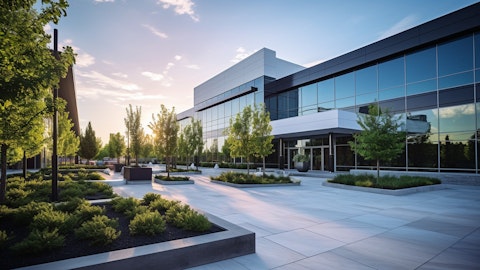Jeff Edison: Adam, I would just add that when — if — there’s always questions about the consumer and where they’re going. The retailer, when they’re looking at staying in one of our centers and how much rent — increase in rent they’re going to give us, that’s a real decision that’s really — I think the leading indicator of what’s going on. And when you have sort of record retention and record spreads, it’s a great indicator that the retailers are not seeing the consumer pulling back. There may be some credit card issues, but they are not or they wouldn’t be renewing at this rate. You’d start to see some reduction in those, in both the spreads and in the amount of retention. And as we look very closely, we are not seeing that at this point in time.
Operator: Your next question is from the line of Juan Sanabria with BMO Capital Markets. Please go ahead.
Juan Sanabria: Hi, thanks for the time. Just a question on the funds management initiative noted or opportunity noted at the Investor Day. Just curious on latest thoughts or comments there. And is any of the enthusiasm on recent acquisition opportunities, is that related to funds opportunities or more on balance sheet?
Jeff Edison: Devin, do you want to take that?
Devin Murphy: Sure. Juan, thanks for the question. As we mentioned at the Investor Day, the Investment Management business is a business that we’ve been in since the company’s founding. We have this platform because it allows us to access incremental capital. It expands our acquisition opportunity set and it generates attractive ROIs for us. The ROIs in this business for us are in the high-teens to high 20s, depending upon the strategy that we’re executing. We did mention at the Investor Day two new initiatives. One is the core partnership. The other is a social impact fund targeting gross rankered centers in majority, minority communities. The capital in both of these ventures has been committed by our partners, and our partners have requested that we do not disclose any additional information until we invest in a center in each venture.
We are currently pursuing acquisition opportunities for each venture, and our hope and expectation is that we will be able to give additional detail about these ventures in the first half of the year as we mentioned in December. And so our enthusiasm for the acquisition volume translates into opportunities for both of these ventures, but for also are on balance sheet acquisition opportunities, because, as we’ve said, we expect to generate acquisition volume comparable to what we’ve done over the last number of years on balance sheet and then the acquisition volume that we do in these new ventures is incremental to what we do on balance sheet.
Juan Sanabria: Thank you. And good to hear from you. Just a follow-up question on the acquisitions and how it relates to occupancy. So, what would have the same-store occupancy been? The reported company-wide decrease quarter-over-quarter, I’m assuming there was some modest impact from buying assets that weren’t fully occupied. So maybe if you could just give the same-store occupancy delta sequentially. And just as a follow-up on that, are the acquisition yields that are quoted, are those going in or are those assuming some sort of stabilization in the occupancy, if in fact, they’re kind of below-stabilized levels?
Jeff Edison: Yes, I’ll answer the first one, and then, John, you can step in on the occupancy. It is the in-place income that we’re talking about when we talk about cap rate on what we acquired. John, do you want to take this?
John Caulfield: Yes. And on occupancy, Juan, it was our third quarter, it was consistent, was 97.8 to 97.8.
Juan Sanabria: Thank you very much.
Operator: Your next question is from the line of Haendel St. Juste with Mizuho. Please go ahead.
Haendel St. Juste: Hey, guys, good afternoon I think. So, you mentioned the top 10 neighbors in your watch list, which represent, I think, 2.7% of ABR, can you talk a bit more about who or what categories on this list and what’s embedded in your guide this year for credit loss and what you actually realized for full year ’23? Thanks.
Jeff Edison: John, I think maybe that probably best if you can cover that. Thanks, Haendel.
Haendel St. Juste: Absolutely.
John Caulfield: And I’ll say good afternoon to you, sir. The watch list that we have, I mean, we ultimately have watch list at every center. But the watch list that we’re referring to here are really from a national standpoint, and I’ll clarify, it was 2.3%. I think you said 2.7%. So it’s 2.3% and it’s not — they’re not named. So included in there would be someone like a Joan or a big lot. It’s things like that where we don’t think there’s anything imminent, but it is something that we are watching. And this is where the diversification of our portfolio is really beneficial. So, I mean, even the names that I’m talking about there are 20 basis points and — 50 basis points individually, assuming that they all went. And so we feel very good about our locations and everything.
So in terms of the guidance and what we’re looking at in ’24, this portfolio has been between 60 and 80 basis points over a long period of time, and that is what we have assumed. We feel good about our locations that we have. And, we — our strategy specifically is that format drives results. So we are intentionally limiting our exposure to some of these larger non-grocery anchors.
Haendel St. Juste: That’s very helpful. Could you actually mention what the actual credit loss was for last year?
John Caulfield: Yes. Okay. Sure. So for the year it was — for total year ’23, it was 62 basis points.
Haendel St. Juste: Great. Thanks. And just to follow-up on I think your comments early on redevelopment, you talked about the $40 million to $50 million of capital spend this year and healthy 9% plus returns. I guess I’m curious what is keeping that pipeline so small. I know you’re working on smaller projects, but I’m curious if perhaps there’s a greater opportunity to expand that where that pipeline could grow to over time and how we should think about that. Thanks.
Jeff Edison: Well, Bob, you want to walk through sort of — I mean, Haendel, the answer is it’s really hard to get the volume that we would like to. I mean, we’d love to do twice that amount. This is sort of hand-to-hand combat of taking — buying specific pieces of land, getting the zoning and the other entitlements, getting the store built and leased, and doing that in $1 million to $5 million chunks, it’s a difficult process and that’s why the stuff we’re working on today is two, three years out and keeping the pipeline full and going. That’s how we think about it. But the returns are really good, and therefore, it’s an important part of what we’re trying to do with our centers and in terms of being able to find additional growth opportunities for them.
And if you can help us figure out how to get more volume, we’re all for it. We’re working really hard to get the volume that we are. And I think we feel good about being able to continue that. But it’s not an easy process getting those out of the ground and going through the full process, it takes time. We’re lucky that all of them that we’ve done are full basically at this point. So we’ve done a really good job with them. It’s just — it’s hard to do a lot more volume than what we’ve been able to put on the board.
Bob Myers: I’ll just add a couple of things too, Jeff, because not only do we think the portfolio can generate the $40 million to $50 million per year, and you touched on, I mean, we’re doing a lot of Starbucks, Chipotle. Chipotle, we’re repositioning some of the boxes with EoS Fitness, Ross, Five Below as an example, but one thing that we’re very focused on is finding development opportunities or redevelopment opportunities as part of our acquisition strategy. And as we mentioned earlier, we’ve closed on 14 assets in 2023, eight of those 14 assets had some sort of development or redevelopment capability, which is also why you see the 87% occupancy level, is that we’re very intentional about wanting to continue to drive this portion of our business and we are getting really good returns, to Jeff’s point, between 9 and 12. So you’ll see that we’re going to run a parallel path between the existing portfolio and our acquisition strategy.
Haendel St. Juste: Got it. That’s helpful. That makes sense. I was also trying to ascertain, really if there’s anything different about your portfolio than perhaps your peers. A lot of your peers have pipelines that are far larger, but it sounds like as part of the opportunities on the acquisition side that you’re sourcing today, that could lead to perhaps more redevelopment opportunities overall in the portfolio. Okay, guys, I think that was it for me. Appreciate the time.
Jeff Edison: Thanks, Haendel.
Operator: Your next question is from the line of Dori Kesten with Wells Fargo. Please go ahead.
Dori Kesten: Hi. Thank you. I apologize if I missed this, John, but did you say what your intentions were regarding the swap maturing later in ’24? And is that assumed in guidance now?


